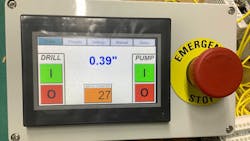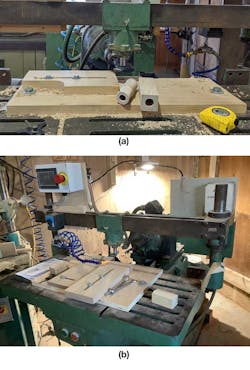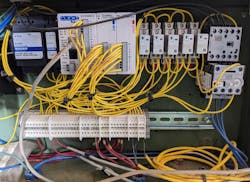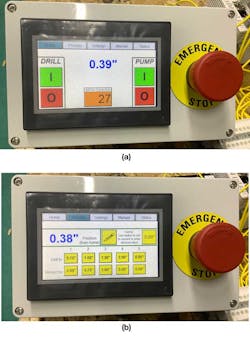Automation a Scalable Solution for Smaller Manufacturers
The words “industrial automation” may conjure up images of massive factories filled with equipment and machinery turning raw materials and parts into finished goods. It is equally true that a lot of manufacturing is performed at a much smaller scale, in small shops and even garages. At many of these smaller operations, the work is performed manually, and the users may think that automation is out of their economic and technical reach.
Calling on Automation
My client in this case is actually a relative who builds about 20,000 wooden game calls each year. These calls are a cylinder that make a sound attractive to ducks, geese, deer, crows and elk. Some calls make mice sounds to attract predators. The details, sizes and shapes vary, but the basic construction requires boring out the center of the material to receive the proper reed.
The work is performed substantially by hand, and the operator begins each piece by placing the wooden blank into an older horizontal drilling machine. This machine is hydraulically powered, and originally used limit switches and hardwired relay logic to extend the rotating drill bit a preset distance, then retract it after the drill cycle was completed (Fig. 1).
One problem with this arrangement, other than the fact that it required manual setup adjustments for making different parts, is that when drilling a hole 3 in. or deeper into the wood it is much better to first drill in part of the way, then retract the bit to release the cuttings, and then to repeat this cycle a few times as needed. If not done in this way, the hole may not be drilled cleanly, or there is a chance of scoring the wood in an undesirable manner. The basic machine had no capability to perform a sequence like this, or any variations to improve production.
I was asked to create a small automation system that could perform this sequence and allow easy configuration of the desired number of drilling steps and depths.
One Step at a Time
Based upon the operational needs, the I/O count and the small available installation space in the existing electrical cabinet, I knew that a stackable micro-modular PLC would meet the need.
Analog I/O capability was important because for best flexibility it was necessary to obtain the drill head position feedback using a linear potentiometer instead of only relying on fixed-position discrete limit switches. In addition, the automation system would need to be connected to monitor and control other devices including:
- Hydraulic pump
- Solenoids to operate the extend/retract cylinder
- Drill motor
- Solenoid for the air clamp holding the workpiece in place
The PLC, I/O modules, relays, motor contactor, power supply, linear position sensor and other products were sourced from AutomationDirect, providing the components needed to design and assemble a compact arrangement (Fig. 2).
While the control system could have gotten by with a few buttons and lights, an HMI provided the best configurability. The HMI was installed in an accessible location in a small enclosure, with a hardwired emergency stop button (Fig. 3).
The HMI was configured to work in conjunction with the PLC, providing the following display functions:
- Home: Start/stop buttons for the drill and pump, with an indication of the real-time stroke depth, and a batch cycle counter to help the operator track how many pieces have been made.
- Presets and Settings: Allows the operator to define up to five unique sets of extend and retract distances and set the “home” position of the drill to calibrate the linear transmitter, as well make other necessary settings.
- Manual and Status: Allows the operator to manually operate machine functions and check on the operational status, mostly for diagnostics and testing purposes.
Automation Game Changer
As an automation expert with years of experience within industry, this PLC/HMI configuration was straightforward and similar to what I would develop for many types of end-users. But for my client, who struggled with manual operation of the original equipment, the usability of this drill automation was game changing.
Before automation, my client could drill 100 parts per hour with a cost per operation estimated at $0.30 each. After automation this changed to 150 parts per hour with a cost per operation of $0.20 each. At quantity, the savings are a few thousand dollars annually and resulted in a payback of less than a year. Waste reduction was minimal, but the accuracy improvement resulted in fewer rejected parts.
The real significance of the modern PLC and HMI hardware and associated programming and runtime software is that it is easy and economical to obtain, configure, deploy and operate. The website has plenty of informational materials and how-to videos, and the support team is only a phone call or an email away. There is also a complete array of associated controls and sensor products available, making it simple to specify everything needed for a project.
Small manufacturing operations, even those working out of their garage, will find it feasible to automate their workplace by engaging a local SI, or even performing the work themselves. When properly scaled, automation can help elevate the performance and output of these companies.
Daniel Oberholtzer is an independent systems integrator, consultant and technical support contractor for industrial controls and equipment. His areas of interest and experience include design, installation and repair of control systems and other equipment.
About the Author
Daniel Oberholtzer
Daniel Oberholtzer is an independent systems integrator, consultant and technical support contractor for industrial controls and equipment. His areas of interest and experience include design, installation and repair of control systems and other equipment.




